People always strive to make the surrounding space beautiful and individual, therefore they paint facades and fences with drawings, paint decorative objects in unusual colors. For painting small areas, you can take a spray can or brush, but staining of significant surfaces with such methods will be too long. When decorating facades or fences, it is convenient to paint with an airbrush, which allows you to quickly create real masterpieces on the walls.
- What is this device
- We select an airbrush
- Paint selection
- Features of airbrushing
- Little tricks at work
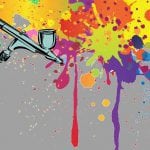
What is this device
Many, hearing an unfamiliar name, will be interested in: “What kind of device is this? What is it for? What is the difference from other tools used for painting or painting? ”
This device is similar to a spray gun, but has a different principle of operation: a jet of dye produced under high pressure makes it possible to accurately paint over large areas.
Working with an airbrush allows you to do wall painting in the interior of the premises, decorate facades, fences, decorate the car body. With it, you can paint over large surfaces, draw thin fine lines, creating amazing works.
to contents ↑We select an airbrush
Depending on what kind of artwork is planned, choose an airbrush model. Most often, inexpensive coloring devices with a thin nozzle and needle are used. Such units are quite suitable for beginners. But for those who plan to seriously engage in airbrushing, when buying an apparatus, one should pay attention to the following:
- The volume of the removable tank (the optimal capacity is 2 liters or slightly more).
- Sealing the needle and nozzle (Teflon seals are the best option).
- The diameter of the nozzle (it should not be less than 2 mm).
- Easy exchange of the main parts (tank, trigger, air and material nozzles).
- Resistance of sealants to the action of reagents used.
- Existence of pressure and dye supply control.
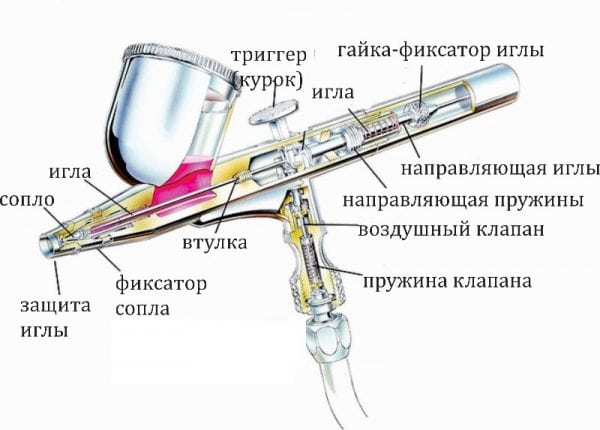
The acquisition of the tool, taking into account all the characteristics, will allow economical and high-quality painting on various surfaces.
When choosing, you should also pay attention to the dye supply method and acquire the desired option depending on the object to be painted:
- Single action with pressure control function. The model is easy to operate, does not require special skills, suitable for beginners. It is not difficult to use: when you press the trigger, the dye is sprayed evenly, and the supply pressure is regulated using a trigger (special valve). Typically, these models are purchased for wall painting with acrylic paints. The disadvantage of this device is the inability to draw thin lines, small elements.
- Single action with dye feed control. From the first option, this airbrush differs only in its ability to change the density of the applied paint layer or spray it onto the surface using an aerosol. Using various techniques, this unit can draw quite complex elements. Most often, this particular model is purchased for decorating interiors, painting facades or fences with simple drawings, and painting small decorative objects.
- Double acting with or without needle.This is an expensive professional option with many features for those who plan to paint serious paintings on walls or cars. This model allows the artist in the process of work to easily control the supply of dye and the power of the air stream using a trigger, and the position of the needle adjusts the flow of the composition. The same device without a needle can quickly and evenly paint a large area. As a rule, professionals choose the option with a needle; all design murals are carried out using such units.
The right choice of tool will facilitate the work, provide paint savings, will provide an excellent result.
to contents ↑Paint selection
To decorate the walls, you need to take paints intended for airbrushing, taking into account the type of base on which the drawing will be applied. The most common are the following formulations:
- Water based polyurethane. Durable, quick-drying, able to withstand temperature extremes. The compositions are hypoallergenic, using them, you can not use protective equipment. Suitable for outdoor or indoor use.
- Acrylic water-soluble (sometimes White spirit or alcohol can be used as a solvent), suitable for any base. Their use is possible for decorating walls indoors, painting facades or drawing a picture on the car body. It is easy to use such paints, they evenly lie on the surface, dry quickly, are non-toxic, do not require the use of a protective suit and a respirator.
- Acrylic solvent. It is diluted before use with a special solvent, as a rule, it is sold complete with concentrate. Toxic - when working with them, it is necessary to use protective equipment. Rarely used, usually in private car repair shops.
Features of airbrushing
Conditionally, the process of creating airbrush painting can be divided into stages:
- Sketch selection. A drawing is thought out, its color scheme, a sketch is created on paper.
- The area for work is being prepared.
- The paint is selected, which fills the cylinder of the painting tool.
- The selected surface is painted.
- Drying and fixing with varnish is carried out (not always done).
The surface is prepared in order to draw on it, in the same way as for painting:
- polished;
- washes;
- is dried;
- degreased with white spirit (you can use other alcohol-containing compounds, but this is the most affordable).
After such preparation, you can begin to draw.
Painting with an airbrush is not difficult, although it will take some time for beginners to acquire a certain skill. To get a quality result, you must follow three rules:
- Begin spraying the ink over a piece of cardboard or other unnecessary material. It happens that a freshly charged unit “spits” by spraying out clots of paint, and this can ruin all the work. It is enough to let out a small stream on unnecessary material, and then begin to draw.
- The jet of the coloring matter should be applied in smooth, measured movements - this will help to avoid streaks, irregularities when drawing, especially when decorating walls or other vertically standing objects.
- Do not keep the dyeing device close to the surface - the paint layer will lie unevenly, streaks will occur.
Having finished drawing, you should immediately rinse the airbrush with a solvent from paint residues, clean the needle and nozzle. The solution is selected depending on the composition of the coloring matter.
For example, after water-soluble products, you can simply rinse the instrument with water.
to contents ↑
Little tricks at work
Having figured out how to paint with an airbrush, you can create a picture on the wall or beautifully paint the fence. A few tips from the masters will help speed up the process, make it more convenient. These recommendations are suitable for both beginners and those who are not the first time to paint on the walls:
- When operating a coloring device, it is advisable to keep it perpendicular to the surface. When drawing a picture on a horizontal plane, the paint spray angle should be greater than 45ᵒ. This technique will evenly distribute the dye.
- The intensity of the coloring, the thickness of the lines, the quality depend on the distance between the apparatus and the decoration. If you want to change this distance, then this should be done smoothly, without jerking.
- If drips occur, do not fix them immediately. It is necessary to wait for drying, and then carefully clean the excess paint with fine emery cloth, and then correct the picture.
- To make the creative process faster, it is advisable to have several containers for different colors - this will speed up the process of changing colors. You no longer need to clean the additional tank, just rinse the device and fasten a container with a different shade of paint to it.
Using an airbrush, you can paint a large area in a short time, while the dye will be spent sparingly, will lie on the base evenly, and the picture will turn out beautiful. By changing the flow of the mixture, using this apparatus it is easy to create realistic, long-lasting paintings on the walls.

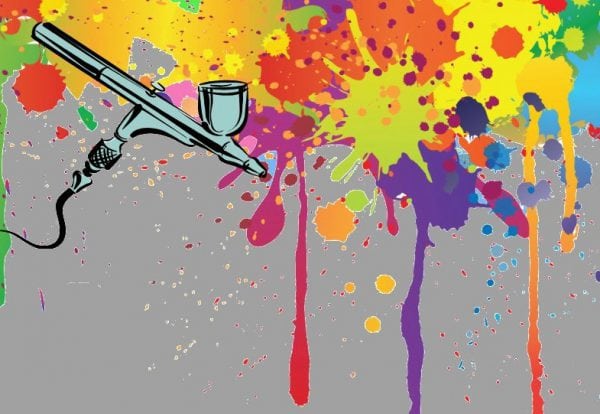
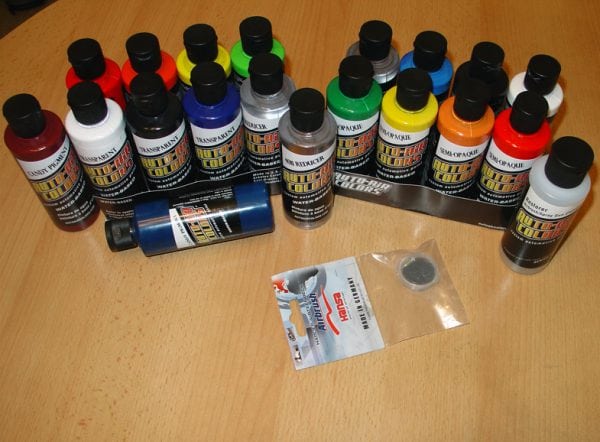
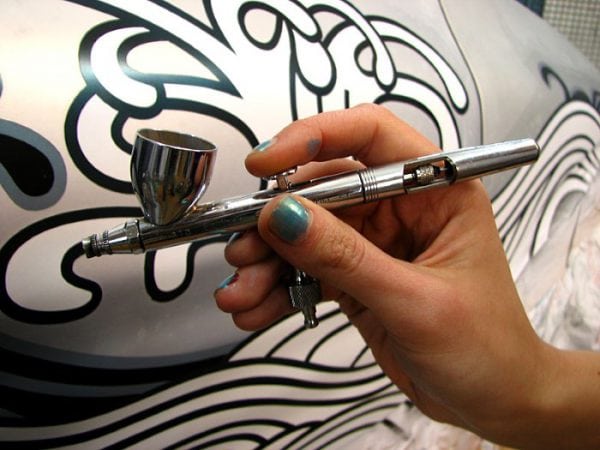
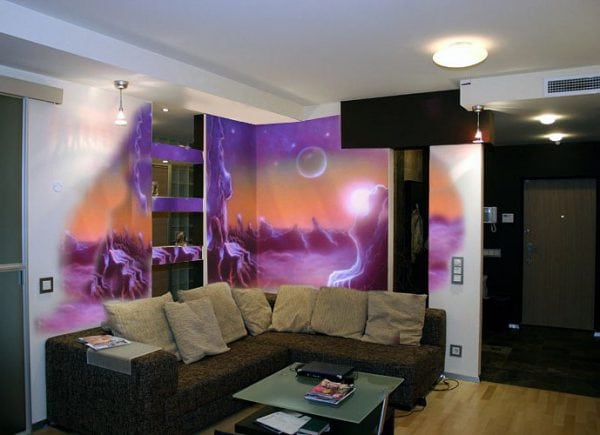



Thanks for the article, everything is accessible and understandable :-)